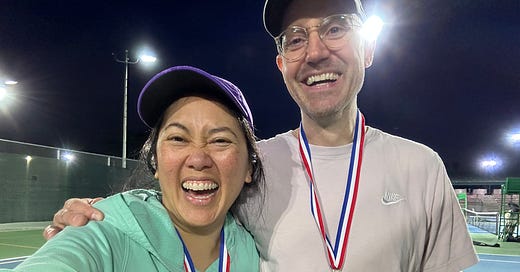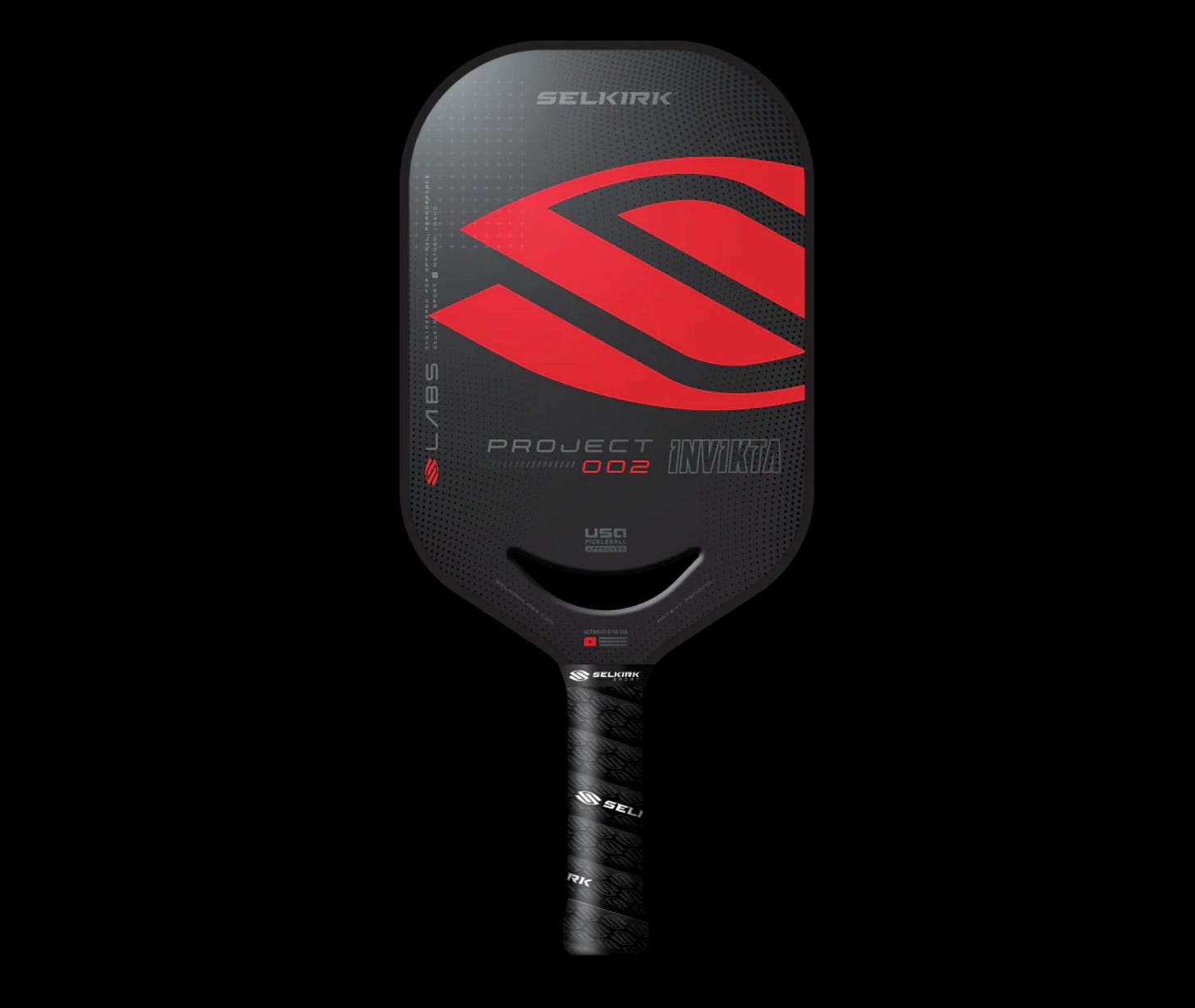How I chose my current paddle
Pro women players are going for power and speed in paddles. Should we?
I sent my last newsletter about a year ago, after which I decided to stop sending the newsletter because I wanted to spend time playing pickleball instead of writing about it. And I’ve done that! I’ve entered several tournaments in women’s doubles and mixed doubles at 3.5 and most recently at 4.0. I’ve gotten two more bronze medals. Still working on that gold medal energy! More importantly, I spend money on tournaments in order to play up with opponents who will help my game improve—not necessarily to win.
I never meant to make this newsletter about gear, but I’ve been overwhelmed with decision fatigue over my next paddle. I’m a soft game player (but aspiring hard-hitter), and my best shots are my drop shots and dinks. I get a lot of balls driven at me, though, so I need something with a bit more pop so blocked shots come back with a little more speed.
Like so many others, my favorite format to watch is pro women’s doubles.* The game seems to speed up with every new tournament. I’ve noticed a trend among the top women’s pro players towards thin, poppy paddles of varying lengths and weights. These athletes are sponsored by brands that can afford to offer sponsorships, so I don’t assume brand allegiance. Still, it’s interesting to see which paddles in each line the pros gravitate towards.
Among Joola players, Anna Bright favors the Joola Solaire, which is a heavy, square-shaped 14mm paddle. Lea Jansen also chose Solaire when signed with Joola. Allyce Jones used to rep the Ben Johns Hyperion 14mm but seems to have switched to the Solaire, too. Etta Wright was using a Ben Johns Hyperion 16mm early in her sponsorship, but she has switched over to a 14mm Simone Jardim Hyperion Swift, also the paddle of choice for Lacy Schneemann. (side note: I’m pretty sure this is also the paddle stick figure Brendon Long used to win gold at PPA Red Rock—easy to tell by the blue lines and yellow logo).
Many of the Selkirk pros seem to be using variations on the Power Air. Catherine Parenteau went from a Paddletek something to the stiff, lively Power Air Invikta and she’s been sweeping medals with it. Maggie and Mary Brascia have been playing with the elongated Selkirk Labs 002 to great success lately (Maggie switched from the Power Air and Mary switched from the 003). Reviewers say the 002 is the precursor to the Power Air, with more power, a softer face, and a less-forgiving sweet spot, but I haven’t tried it myself. In Tyson McGuffin’s latest podcast, McGuffin himself says the 002 can suffer from delamination just as raw carbon fiber thermoformed paddles do, so buyer beware.
Anna Leigh Waters is apparently using the Paddletek TS-5 but it sounds like some new paddle line is on the way. (Also, I think ALW is the true GOAT and could probably use a fly swatter to win.) Andrea Koop uses a Tempest Wave and Irina Tereschenko uses a Bantam EX-L. I’ve never been particularly interested in the Paddletek line, but maybe they’ll do something innovative this year with ALW.
Callie Jo Smith and Lucy Kovalova have both switched to the Onix Evoke Premier Pro Raw Carbon Fiber paddle. I believe I heard on a broadcast that Kovalova is using the thinner 10mm and Smith is using the 14mm, but I haven’t been able to factcheck that.
Some of my favorite players rep smaller brands. Jessie Irvine has switched over from the standard Engage Pursuit to the unibody, foam-injected Pursuit Ultra, and I believe she uses the elongated MX shape with the thinner core. Meghan Dizon switched from the oval ProKennex Black Ace Ovation to (I think) the Black Ace XF, which is extra long with squared off edges—I’ve played with and against the Black Ace and I think it’s the most powerful (and hardest to control) paddle there is.
Right-side specialist Vivienne David uses the Crbn 1X (I think 16mm), which is like a control paddle with extra power. That was probably my top choice for my next paddle, but my partner just had to return his three-month-old Crbn 1X under warranty (1 out of 10 balls sails long and it makes weird, crunchy noises on one side).
Though some people will tell you that a pickleball paddle should last up to 5 years, I think the lifespan is much closer to six months if you play a lot—especially with new designs and materials changing the speed and spin of shots. Ben Johns replaces his paddle every two tournaments, moving a paddle from practice to tournament play, which works out to about once a month.
My Crbn1 is about 9 months old and feels like a smooth, powerless pillow now. Replacement frequency probably also depends on the core; my super-thin, two-year-old ProKennex ProFlight still plays the same as it used to, but it no longer suits the way that I want to play. The escalating prices on paddles is pretty galling considering their brief lifespans, but I guess there are more expensive hobbies to have.
The current wave of smaller brand thermoformed paddles (SixZero, Vatic, Legacy Pro, Crbn) all sound pretty similar—solid sweet spot, more power, enough control for the NVZ, possibility of delamination problems when the double layer face deteriorates. I had purchased a SixZero 14mm but I have no idea when it might ship. Last week I borrowed a Solaire from a Joola rep and I’ve decided to stick with it at least through my next tournament. (Seek out a rep in your area who can let you demo a paddle and maybe get you a discount off of retail price.)
It’ll be interesting to see what comes up next in paddle tech, too. Over the next couple of months, we’re likely to see more EVA foam paddles in the vein of the unapproved but fun Diadem Vice (super fast and quiet). I’m curious to see what the Joola Perseus and the Selkirk 005 are going to be about.
What paddles are you into these days? What paddles are you curious about? I’d love to hear your thoughts.
Next week I’ll continue the gear theme with an assortment of things I use to improve my game.
*Most pickleball tournaments categorize players by gender and age, which feels anachronistic. Perhaps we’ll one day use DUPR to move from gender categories to combined numerical ratings, with people specializing in playing left side or right side.






